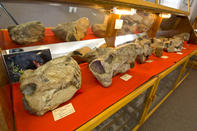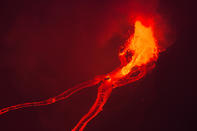Mass Extinction Events
Five mass extinction events have hit the planet since the first single-celled organisms split and multiplied. These events have snuffed out more life than we can imagine in the relative blink of a Brontosaurus's eye. The first happened about 440 million years ago, towards the end of the Ordovician period.

Next came the Devonian mass extinction at about 365 million years ago. Both put paid to 80 to 85 per cent of life on Earth. Biodiversity bounced back, only to be hit by the third great extinction during the Triassic period about 210 million years ago where 70 to 75 per cent of species threw in the towel.
Then, about 65 million years ago, during the most famous extinction of the Cretaceous, dinosaurs were hurried off this mortal coil by a massive asteroid collision.
But the humdinger of all extinctions, the undisputed heavyweight obliterator of life, came at the tail end of the Permian period about 250 million years ago. A catastrophe of such magnitude struck the planet that 95 per cent of all life disappeared, leaving a fossil record almost wiped clean of species.
Culprit of Hyper-extinction

Michael Benton, Professor of Vertebrate Palaeontology and Head of the Department of Earth Sciences at the University of Bristol, documents the various theories behind the hyper-extinction events in his book When Life Nearly Died. In his opinion, the culprit was runaway global warming triggered by volcanic eruptions.
It probably happened like this: massive volcanic activity in Siberia pumped the atmosphere with enough carbon dioxide to trigger a relatively minor global warming event, just enough to start melting polar ice caps. The melting caused a release into the atmosphere of a compound called methane hydrate, which was frozen into polar sediments.
This form of methane, a highly potent greenhouse gas, tipped the system into overdrive, creating runaway global warming. Increased heat, along with acid rain caused by the sulphur dioxide (SO) also released during the volcanic activity, killed plant life across the planet.
Once the global life-support system collapsed, it took the rest of the food chain down with it. Herbivores starved to death as their grazing wilted. Predators followed suit as their own food source rotted around them. Life at the bottom of the ocean suffocated as ocean currents stopped churning, depriving the seabed of oxygenated water.
Calculating the total temperature increase that almost finished life on Permian Earth, Benton puts the figure at 6°C. The Intergovernmental Panel on Climate Change (IPCC) calculated its own upper estimate of temperature increase in the next one hundred years: 5.8°C. But more recent work suggests these increases could be much higher.
A meeting of scientists in Berlin in 2003 revised the temperature increase during the next century at anything from 7°C to 10°C. Following this, Oxford University's climateprediction.net project ran more recent and extensive climate change models.
An estimated atmospheric carbon dioxide level of 550 parts per million (ppm) - expected to be reached by mid-century - could bring about a maximum increase in some parts of nearly double the IPCC's upper figure: 11°C by 2100. Some scientists criticise this figure, but it is part of the slow refinement of the modelling process so it should not be dismissed outright.
The researchers pointed out that it is impossible to define the 'safe' upper limit of atmospheric CO. At the same time, the British MP assigned to the International Climate Change Taskforce, Stephen Byers, told the BBC that a 'carbon dioxide concentration of over 400 ppm would be dangerous'.
We are already committed to a 2°C increase in terms of how the planet's thermostat distributes heat. A lag exists in the system because it takes a long time for the heat trapped by greenhouse gases to be distributed throughout the system.
By Leonie Joubert